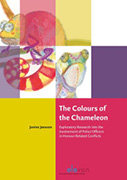THE COLOURS OF THE CHAMELEON: EXPLORATORY RESEARCH INTO THE INVOLVEMENT OF POLICE OFFICERS IN HONOUR-RELATED CONFLICTS

Author: Janine Janssen
Publisher: The Hague: Eleven International Publishing, 2015. 140p.
Reviewer: Wendy Aujla | January 2017
The Colours of the Chameleon provides a sociological lens on the various social positions and roles a police officer and other professionals are associated with in honour-related cases. The chameleon is shown throughout the book as a design as well as a metaphor, to illustrate how the life of a person is just as colourful and constantly changing as the creature of the title. An individual is more than what others may perceive him or her to be, as life challenges us to take on numerous roles which may change suddenly in both the family and work sphere. These changes are reflected in role strain or conflict in life, and as evidenced in the chameleon that changes in appearance in response to changes in its environment.
The structure of the book is well organized and consistent with what the author presents in the introductory chapter. The greatest contribution of this book is its central focus on the involvement of police officers in honour-related cases in their private lives and at work. The aim of this qualitative study is to explore the main research question focusing on “police officers who have been personally involved in an honour-related conflict as a consequence of incidents in their private lives or as a consequence of their professional activities?” (p. 68). Case histories, from the National Expertise Centre on Honour-Related Violence (Landelijk Expertise Centrum Eergerelateerd Geweld (LEC EGG)) of the Dutch National Police Force, over a five-year period from 2005 through the middle of 2012 are utilized to examine that question.
In chapter two, the definition and concept of honour are considered in the police context and in Dutch government policy. The author stresses how difficult it is to define the concept of “honour-related violence’ (e.g. threats, abuse, murder, manslaughter, refusal to marry someone, etc.) and how she believes eventually the term will become a “catch-all phrase” to include a wide range of behaviours (p. 25). A strength of this chapter is how honour is conceptualized as a term, depending on the range of behaviours that are included. Also, existing literature about police practice is consulted to include integrity, diversity, and violence against the police. This is useful, as some of the limitations with the existing police literature are well discussed. For instance, “in the literature about integrity and the police, the concept of ‘honour’ is hardly given any attention” (p. 35). Furthermore, a section is included to describe who police officers really are — which is important to set the stage for the following chapters. The first group of officers is called ‘executives’ because they execute or carry out police work, and the second group is referred to as “‘administrative and technical personnel’, or admin and technical staff in short’” (p. 26).
Chapter three highlights sociological concepts such as statuses and roles while focusing on role theory. Sociologist Robert Merton’s key concepts (role set) and role theory are applied to understand how police officers construct meaning or make sense of how they perform a number of different roles. Figures are included with specific examples to effectively highlight this key argument. Janssen then re-examines the main research question from chapter one while narrowing the study down first into five sub-questions, and then including additional sub-questions in chapter four. Case histories and methodological limitations are described.
Chapter five and six concentrate on the main findings and discussion. In chapter five, the author presents a number of cases (N=35) with a clear distinction of whether police officers were involved in honour-related conflicts in their private lives or because of incidents at work. The majority of the cases were about an honour-related conflict in private, with only one case being about conflict as a consequence of professional activities. Janssen looks at whether the police officers involved in the case studies were victims, suspects or involved in other ways. Some of the cases and various types of conflicts (e.g. choice of partner, divorce, relationship with extended family) are included as examples. Chapter six returns to the theoretical framework and concepts of role strain and role conflict as mentioned in chapter three. This chapter offers a more academic discussion of how solutions can be offered to address strains and conflicts that are present in a variety of social roles. A discussion of how role theory can help prioritize different roles or expectations in the family context or at work is offered.
Chapter seven summarizes key points, research questions, theories, and concepts. Limitations with the case histories used are noted; for instance, the fact that only cases known to the LEC EGG were examined. Recommendations are also offered to assist with interpreting the concept of honour and the handling of cases involving police officers, regardless of their ethnicity or cultural background. One important point made by the author is that about diversity and the role of knowledge about cultural backgrounds. “Such knowledge is important in the handling of honour-related cases, but at the same time it is important not to make use of ethnic minority colleagues as ‘cultural specialists’ merely because of their origins” (p. 118). As the author states, being of a particular ethnicity does not suggest that you are a cultural specialist, and it underestimates the skills of other well-rounded police officers. The risk and limitations with a cultural interpretation of investigative findings are presented honestly.
In the last chapter, – the tail of this story – the chameleon as a metaphor is raised again to highlight practical recommendations on how colourful life is and how it is worth listening to the chameleon to prevent future strains and conflicts in honour-related cases.
A unique contribution this book makes is connecting the concept of honour to professionals (especially in the police force) and to those in other areas such as the prison system, probation service, and women’s shelters. Overall, this book is a significant theoretical and practical contribution to the field. I highly recommend The Colours of the Chameleon to researchers, practitioners, professionals, policy makers, police organizations, criminologists, and sociologists.
Wendy Aujla, PhD Candidate, University of Alberta


